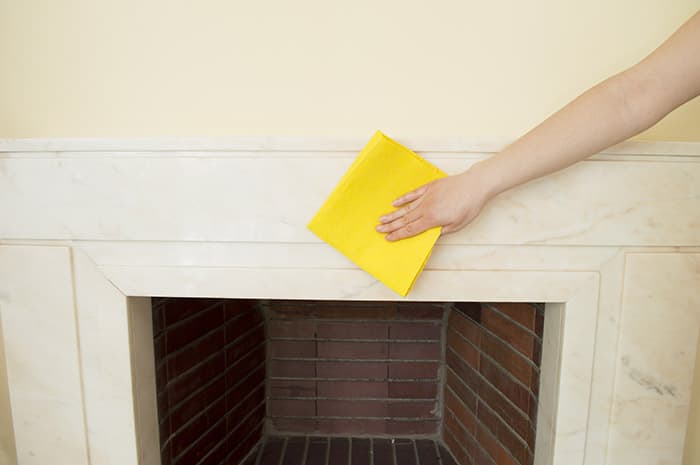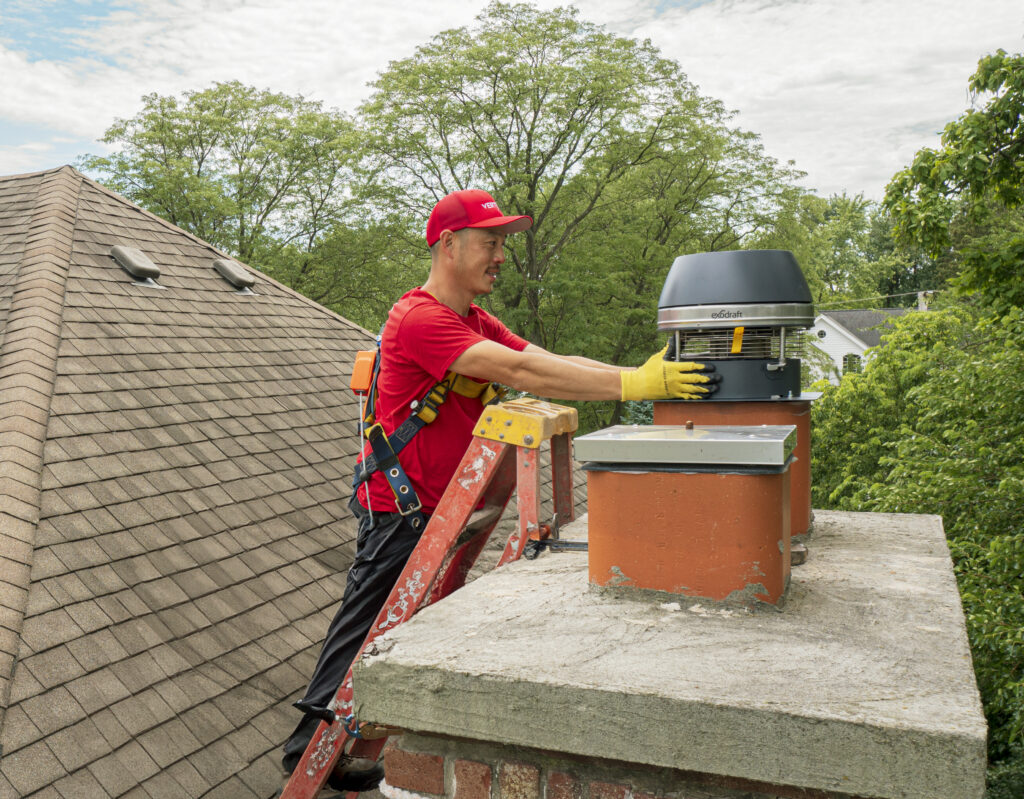
Whether you’re lighting up those logs to keep the house warm or using the fireplace as an eye-catching focal point, it’s important to keep it free of soot, dust and debris. Cleaning a fireplace isn’t hard work, it just takes time, patience and knowledge on how to get the job done adequately.
The main function of a fireplace is to provide warmth. But, the large amount of black soot creeping up the front of the bricks can also be an eyesore. How exactly do you clean a fireplace? You’re about to find out.

Inspect It
First, wait at least 12 hours after your last fire before cleaning your fireplace.
Before cleaning the fireplace, it needs to be inspected. A professional can ensure all parts are in working order, but you can too if you know what to look for. Check to see that the lintel is at least 12 inches high.
The lintel is the steel bar that supports the tops of the opening to the first combustible. The bricks also need to be evaluated. If they're regular bricks rather than fire bricks, they can't tolerate higher temperatures.
They'll begin to crack and the mortar will crumble. If you see signs of this, chisel out the mortar and replace it with high-temperature cement. The damper is another piece that should be reviewed for correct positioning.
Gather Your Supplies

Before you start doing any cleaning, you'll need to get all your supplies ready so you're not rushing around during the actual process of cleaning trying to find what you need. Below is a list of all the necessary items to clean your fireplace.
- Mask
- Long-sleeved shirt and pants, old clothes
- Goggles, protective eye-wear
- Safety mask
- Flashlight
- Old sheets or newspapers
- Towels/rags
- Paper towels
- Broom and dustpan
- Trash bags
- Vacuum
- Scrub brushes
- Dishwashing liquid
The supply list can vary depending on your preferred methods. The biggest concern is your safety.
Protect the Area
Soot, dust and debris are all tiny particles that'll travel surprisingly far into the room. Cover the hearth, nearby furniture and carpet with old sheets or towels.
Roll-away any rugs and wear old clothes and gloves. Soot and ash on any surface will cause even more cleanup once the fireplace is spic and span.
Remove Debris
If your fireplace isn’t used frequently, birds or other small animals may have nested in the flue. Use a broomstick to remove any debris and then secure a top-sealing chimney damper to the flue.
Also, clean around the firebox, the area where the logs burn, and remove the loose ashes. To minimize debris in the air, sprinkle coffee grounds over the ashes. Put on your protective eye gear and safety mask and sweep out the interior of the fireplace from top to bottom.
Follow up with a brush attachment on your vacuum. Also, clean the damper ledge with the stuff brush attachment on the vacuum, this is where creosote dust builds up most.
Select a Method
Start with the least aggressive chemical and move your way up as needed. A dish washing liquid, such as Dawn, is the easiest and quickest method to remove debris that needs more than a vacuum.
Since smoke and ash leave a greasy tar, a half-cup of dish soap and four cups of hot water will help remove the film. Use a nylon bristle brush to scrub the brick.
If a residue is still sticking around after dish soap and water have had time to work their magic, try dish washing liquid and salt. One cup of table salt mixed with one cup of dish soap will provide that extra scrubbing abrasiveness needed.
Mix the two ingredients to form a paste, once the paste sits on the troublesome area for a few minutes use a scrub brush to remove the solution, rinse and vacuum any salty leftovers.
For a natural disinfectant and to help reply pests, add borax to dish washing detergent. Two tablespoons of borax, one tablespoon of dish washing liquid and four cups of hot water will create an unbeatable solution. For a stronger mixture, use half-cup ammonia, four cups of hot water and one-fourth cup dish washing liquid.
The strongest cleaning solution that is often used by the professionals is trisodium phosphate (TSP). TSP can be found at home improvement stores and can cause damage to all surroundings. It will stain or discolor metal, strip paint, dissolve wall- paper, stain hardwood and etch ceramic tile and natural stone floors. TSP should remove all soot that can be safely removed.
Remove Build-Up
The real trick to cleaning brick fireplaces is the amount of elbow grease you put into the equation. However, sometimes you must accept the fact that some stubborn stains will remain. Over scrubbing can do more harm than good!
Dip the brush into the cleaning solution of your choice and scrub the interior of the fireplace, working in small circular motions. To avoid streaking, start at the bottom and work your way to the top.
Rinse with a rag and, depending on how dirty your fireplace is, you may need to repeat the process.
If your fireplace has glass doors, mix a solution of half-cup of white vinegar and half-cup of water in a fresh spray bottle. Spray the doors with the solution and sprinkle some ashes onto the towels to act as a light abrasive. Gently scour the doors, and repeat with fresh paper towels.
Keep It Clean
A clean fireplace isn’t just a beautiful sight, it’s good for your health and it helps prevent house fires. The creosote buildup does more than reduce the airflow to your chimney, it’s also toxic to your health.
Physical contact can cause irritated skin and eyes, breathing it in can cause respiratory issues and studies have shown that long-term exposure to creosote can lead to cancer.
Once you have finished cleaning your fireplace, consider spreading the ashes on the flower beds. The debris is an excellent source of calcium and other nutrients for the plants. Plus, if soft-bodied pests such as slugs and snails invade your space, ashes will act as a deterrent.
The more you use your fireplace, the more often it should be cleaned. We recommend cleaning it after every 50 or so fires to ensure safety, improve looks and prevent any disasters.
Keep your fireplace clean longer by using dry wood, vacuuming weekly and only using water to put out a fire if it’s an emergency.
Signs the Chimney Needs Cleaning
- Odors coming from the fireplace when not in use
- Fires that burn slowly or poorly
- Smoke fills the room
- A black damper
Before lighting your next fire, remember that according to the National Fire Protection Association, unclean chimneys and fireplaces are the leading cause of structure fires. And, thirty percent of fires came from failure to clean equipment, primarily chimneys.
A clean fireplace and chimney is a must-have in any home. If you're not sure when the last time you cleaned your chimney was, contact us today to have your chimney inspected and cleaned by Chicagoland's best chimney service company!
